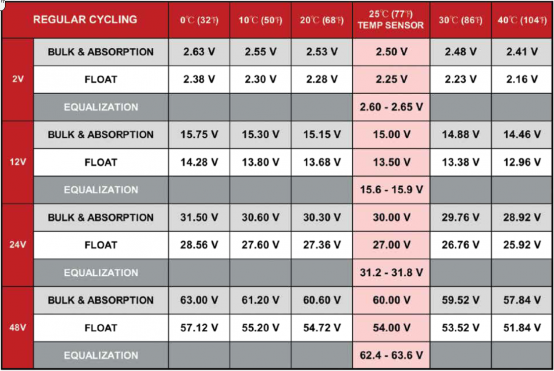Batteries
Infrequent Cycling[1]Edit
The flowing chart is to be used where the battery bank experiences infrequently cycling or rest at full state-of-charge for extended periods - ex. a backup application.
Regular Cycling or Partial State of Charge RecoveryEdit
The below chart is to be used in situations of full-time regular daily cycling (ex. off-grid applications) or recovery where the battery bank has experienced repeated partial state-of-charge operation.
General NotesEdit
These two charts work for most battery installations in the field.
EqualisationEdit
Reversible sulfation can often be corrected by applying an overcharge to an already fully charged battery.
Set a current limit of 200mA and voltage to rise to between 2.50 and 2.66V/cell (15 and 16V on a 12V battery) (best 15.9V) for about 24 hours. Increasing the battery temperature to 50–60°C during the corrective service further helps in dissolving the crystals.
AbsorptionEdit
Absorption charge time must be adequate. To fully charge the battery bank to 100% SOC, the Absorption charge must be completed. Failing to fully charge the battery bank will lead to sulphation build-up, capacity loss and eventual failure of the battery bank.
When the initial Bulk charge has completed the charge profile should enter into Absorption charge. At this phase, the battery bank has reached approximately 80% state-of-charge. When the Absorption charge stage is reached, the charge current to the battery bank will begin to drop significantly as the internal resistance of the battery bank increases. To complete the charge, it is imperative that the charger continues to push current to the battery bank, forcing it to reach full state-of-charge. This is done by forcing the charger to continue the Absorption charge voltage for a set period of time.
To determine the required Absorption charge time for flooded models, the provided formula is used. To calculate, you must know the available charge current (or max charge current output of the charger) M and battery bank AH capacity C, 0.42= current losses while in Absorption charge. Charge current value (M) is the peak charging Amp output to the battery bank in the Bulk charge. It is common to de-rate this value 20-30% from the peak current in some applications due to increased resistance and a gradual decrease in charge output.
t (hrs) = 0.42 X C / M
To prevent sulfation buildup in flooded lead-acid batteries, it is essential that at least one full Bulk & Absorption charge be completed every 7-10 days. However, it is recommended that the system be sized to bring the batteries to a full state-of-charge on a daily basis. Full state-of-charge requirements will depend on cycle frequency and depth of discharge.

